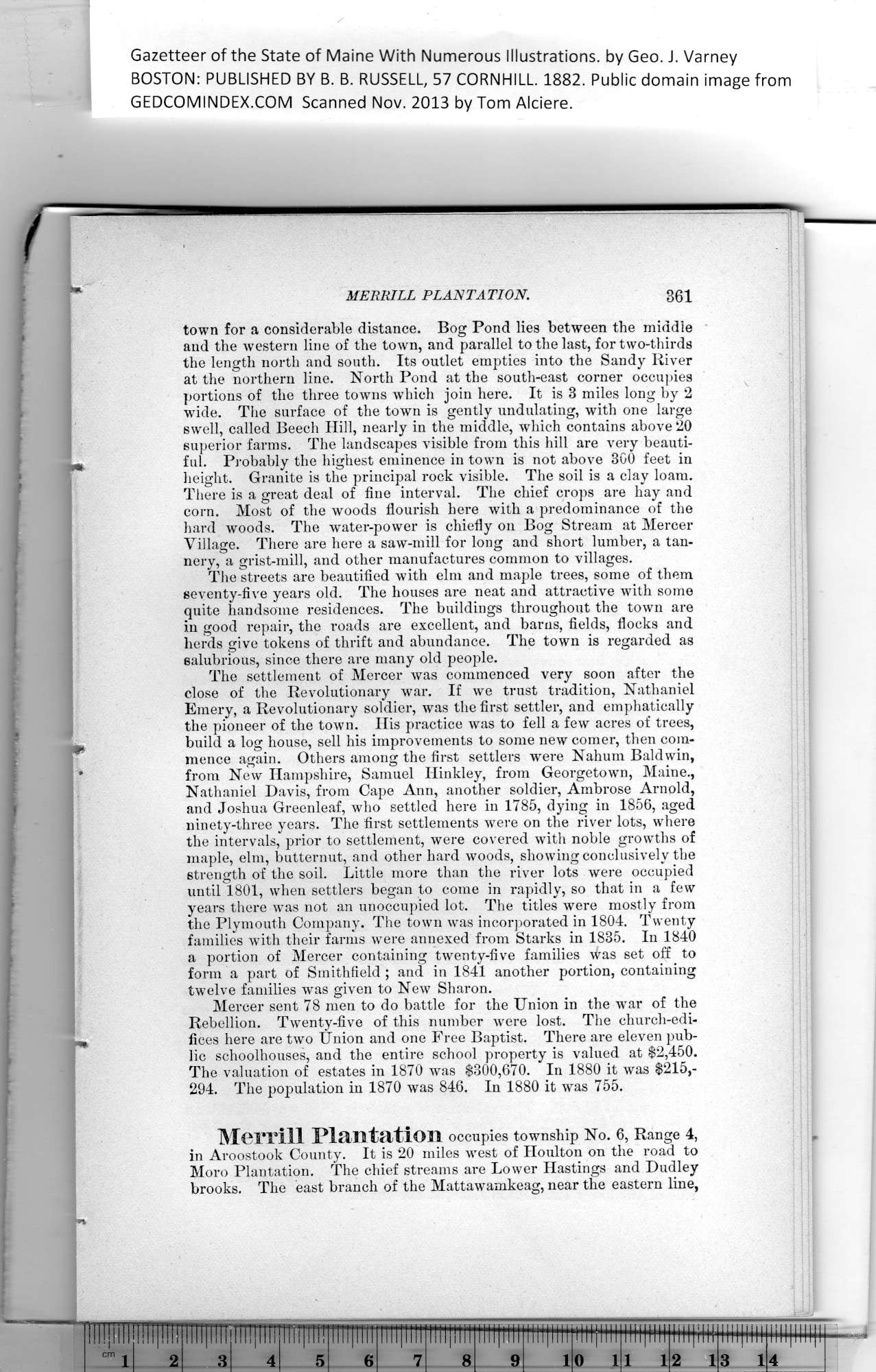|
Gazetteer of the State of Maine With Numerous Illustrations, by Geo. J. Varney
BOSTON: PUBLISHED BY B. B. RUSSELL, 57 CORNHILL. 1882. Public domain image from
MERRILL PLANTATION. 361
town for a considerable distance. Bog Pond lies between the middle
and the western line of the town, and parallel to the last, for two-thirds
the length north and south. Its outlet empties into the Sandy River
at the northern line. North Pond at the south-east corner occupies
portions of the three towns which join here. It is 3 miles long by 2
wide. The surface of the town is gently undulating, with one large
swell, called Beech Hill, nearly in the middle, which contains above 20
superior farms. The landscapes visible from this hill are very beauti-
ful. Probably the highest eminence in town is not above 300 feet in
height. Granite is the principal rock visible. The soil is a clay loam.
There is a great deal of fine interval. The chief crops are hay and
corn. Most of the woods flourish here with a predominance of the
hard woods. The water-power is chiefly on Bog Stream at Mercer
Village. There are here a saw-mill for long and short lumber, a tan-
nery, a grist-mill, and other manufactures common to villages.
The streets are beautified with elm and maple trees, some of them
seventy-five years old. The houses are neat and attractive with some
quite handsome residences. The buildings throughout the town are
in good repair, the roads are excellent, and barns, fields, flocks and
herds give tokens of thrift and abundance. The town is regarded as
salubrious, since there are many old people.
The settlement of Mercer was commenced very soon after the
close of the Revolutionary war. If we trust tradition, Nathaniel
Emery, a Revolutionary soldier, was the first settler, and emphatically
the pioneer of the town. His practice was to fell a few acres of trees,
build a log house, sell his improvements to some new comer, then com-
mence again. Others among the first settlers were Nahum Baldwin,
from New Hampshire, Samuel Hinkley, from Georgetown, Maine.,
Nathaniel Davis, from Cape Ann, another soldier, Ambrose Arnold,
and Joshua Greenleaf, who settled here in 1785, dying in 1856, aged
ninety-three years. The first settlements were on the river lots, where
the intervals, prior to settlement, were covered with noble growths of
maple, elm, butternut, and other hard woods, showing conclusively the
strength of the soil. Little more than the river lots were occupied
until 1801, when settlers began to come in rapidly, so that in a few
years there was not an unoccupied lot. The titles were mostly from
the Plymouth Company. The town was incorporated in 1804. Twenty
families with their farms were annexed from Starks in 1835. In 1840
a portion of Mercer containing twenty-five families was set off to
form a part of Smithfield ; and in 1841 another portion, containing
twelve families was given to New Sharon.
Mercer sent 78 men to do battle for the Union in the war of the
Rebellion. Twenty-five of this number were lost. The church-edi-
fices here are two Union and one Free Baptist. There are eleven pub-
lic schoolhouses, and the entire school property is valued at $2,450.
The valuation of estates in 1870 was $300,670. In 1880 it was $215,-
294. The population in 1870 was 846. In 1880 it was 755.
Merrill Plantation occupies township No. 6, Range 4,
in Aroostook County. It is 20 miles west of Houlton on the road to
Moro Plantation. The chief streams are Lower Hastings and Dudley
brooks. The east branch of the Mattawamkeag, near the eastern line,
PREVIOUS PAGE ... NEXT PAGE
This page was written in HTML using a program written in Python 3.2
|
